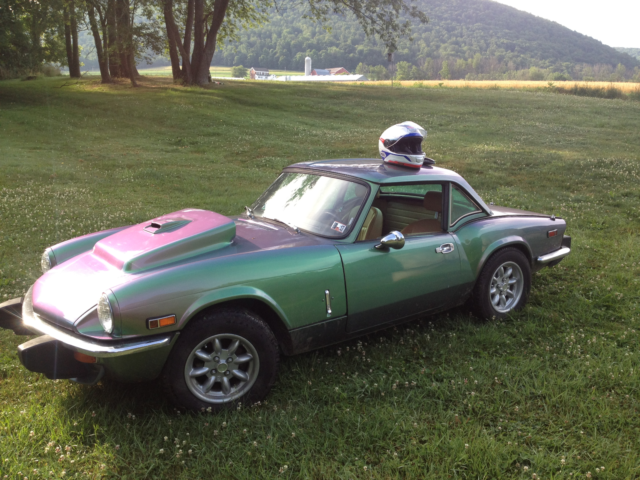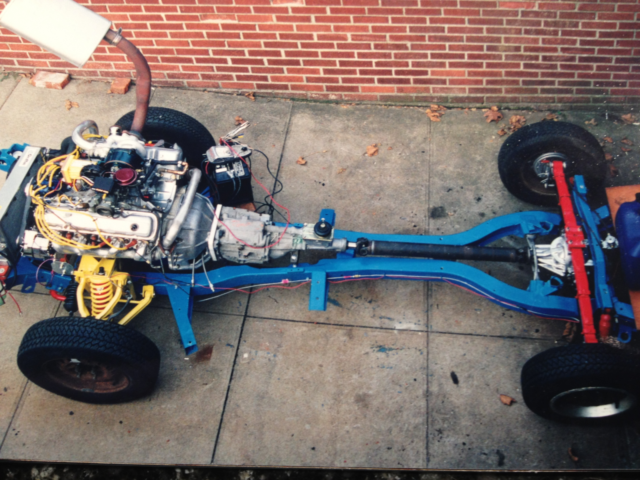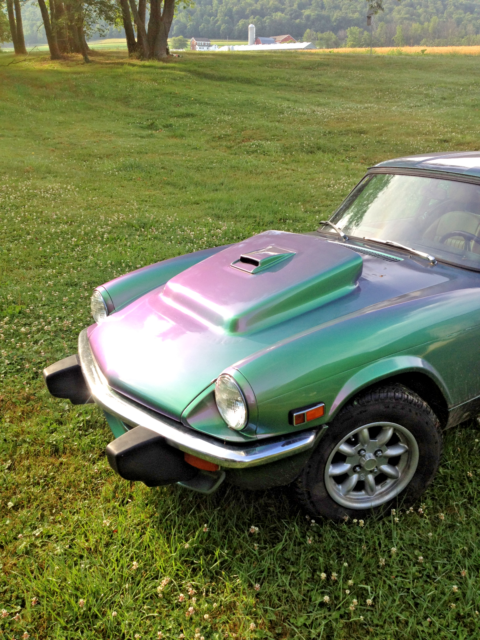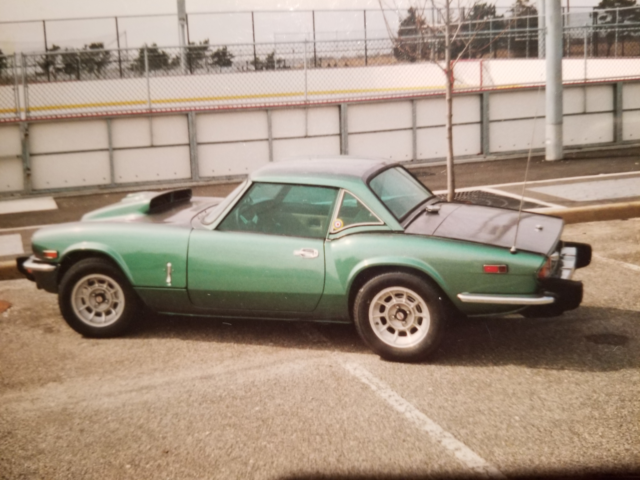Olsmobile F85 V8 powered Triumph
- Price:
- Location: Loganton, Pennsylvania, United States
- Make: Triumph
- Model: Spitfire
- Type: Convertible
- Trim: hard top
- Year: 1975
- Mileage: 15,500
- VIN: FM33670U
- Color: Green
- Engine size: 215 Olds V8
- Number of cylinders: 8
- Power options: Four piston calipers, vented rotors, GT6 uprights
- Fuel: Gasoline
- Transmission: Manual
- Drive type: RWD
- Interior color: Tan
- Options: Cassette Player, CD Player, Convertible
- Vehicle Title: Clear
1975 Triumph Spitfire hard top Description
I apologize for the lack of photos. I have many more but due to size constraints, they won't load up.I'm the second owner of thisspitfire. I purchased it with a blown engine in 1976 and I've been its owner for 41 years. Untold hours upon hours and days upon days have been spent driving and living with the Spit.When the Spit had the 1500cc 4cylinder, I taught my girlfriend how to drive a manual. We also put a dent in the bonnet with our body weight pressing the bonnet to the valve cover bolt, (hey we were young and, well you know). I could write a book about the unusual things that happened to the Spit, like when a Christmas tree plummeted from a six story balcony and thumped onto the bonnet, or Misty, (not her real name), threw a pile of bricks on the Spit only two weeks after I completed the first restoration. Maybe I deserved it but the Spit didn't. Or the time the fuel tank vent clogged and the electric fuel pump created such a vacuum that the bottom of the tank began to collapse causing the pick up tube to puncture the tank resulting in a major fuel leak. Theengine is from a 1963 Oldsmobile F85 Jetfire.It is an original factory Turbo 215 V8. The turbo, intake manifold, carb and plumbing was sold to someone in Arizona and I retrofitted a four barrel. Why did I do this? Mainly due to heat. The turbo was positioned directly on top the manifold and it produced tremendous heat. During extend night driving, the turbo housing, (visible though the opening in the hood scoop), would glow cherry red. The engine compartment got so hot, it could boil brake fluid. The Spitfire has no air vents for the feet and even with a heat shield on the firewall, the floor got so hot, plastic cassette cases would deform.This interior of the Spit is new, it has a AM/FM CD/Cassette deck, four speakers and an electric antenna. The Tach and Speedo are custom while two of the gauges are froma 1968TR250. The car is rock solid but the paint does have some imperfections near the headlight bezels, a chip on the drivers door and the seams on the hood scoop, (rear facing Mopar SixPack type), are now visible. The scoop was fastened to the bonnet with epoxy adhesive and aircraft rivets. Over time with thermal expansion and contraction, the seam has become visible. As with all major retrofits, many custom specialty built parts were necessary to drop the V8 into the Spit's chassis. There is the 5 core aluminum radiator, an oil cooler, custom headers, Nissan four piston calipers, vented rotors, GT6 uprights and springs, hydraulic clutch bearing, custom exhaust and on and on. The original Spitfire rear axle and differential remain in place. I've never had any problem with the differential but the car isn't subjected to hole shots and smoky burnouts. It was a daily driver for two years when I had a long commute. To drive this car one mustbe proficient in operating a manual transmission.The T5 transmission shifts smoothly however, skill is required to release the clutch and start off smoothly. I could go on an on but I'm certain boredom would overcome most readers. After 41 years of ownership, (longer than I've been married),I still have much passion for the Spitfire and Iknow if it sells part of me will regret the loss. There was an article posted in the Spitfire and GT6 Mag aboutmy Spit.Simply google "Olds 215 V-8-Spitfirefor the article and more photos.Its' been fun!
More Triumph classic cars for sale
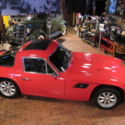 Triumph-powered 1974 TVR 2500M Coupe 2-Door 2.5L
Triumph-powered 1974 TVR 2500M Coupe 2-Door 2.5L
 RARE EXCITING 1980 Triumph TR8 Sports Car TR6 Spitfire V8 Powered, Runs Great!!!
RARE EXCITING 1980 Triumph TR8 Sports Car TR6 Spitfire V8 Powered, Runs Great!!!
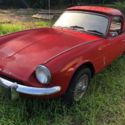 1968 Triumph Spitfire MK3 Convertible Solid Rust Free Triumph Rare Car !!!!!!
1968 Triumph Spitfire MK3 Convertible Solid Rust Free Triumph Rare Car !!!!!!
 1969 Triumph Unknown TRIUMPH BOBBER 100 Miles Orange 650cc Manual
1969 Triumph Unknown TRIUMPH BOBBER 100 Miles Orange 650cc Manual
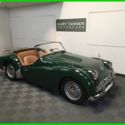 1961 TRIUMPH TR3A SPORTS ROADSTER. TRIUMPH REGISTRY DOUBLE NATIONAL CHAMPION
1961 TRIUMPH TR3A SPORTS ROADSTER. TRIUMPH REGISTRY DOUBLE NATIONAL CHAMPION
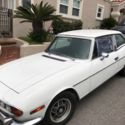 1973 Triumph Stag, Original 3.0 Triumph V8 engine runs great. Auto, AC, Hardtop,
1973 Triumph Stag, Original 3.0 Triumph V8 engine runs great. Auto, AC, Hardtop,
 1968 Triumph TR250 91640 Miles Triumph Racing Green Hardtop 2.5L 6cyl 4 Speed W
1968 Triumph TR250 91640 Miles Triumph Racing Green Hardtop 2.5L 6cyl 4 Speed W
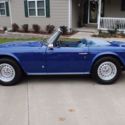 1975 Triumph TR6 California car with Overdrive and No rust. All original Triumph
1975 Triumph TR6 California car with Overdrive and No rust. All original Triumph
 1969 Triumph TR6 22000 Miles Triumph Racing Green
1969 Triumph TR6 22000 Miles Triumph Racing Green
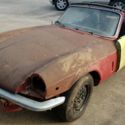 Triumph Spitfire 1,3 Mk4 1972/73 Triumph Herald, Amphycar
Triumph Spitfire 1,3 Mk4 1972/73 Triumph Herald, Amphycar
 Triumph-powered 1974 TVR 2500M Coupe 2-Door 2.5L
Triumph-powered 1974 TVR 2500M Coupe 2-Door 2.5L
Year: 1974
Mileage: 57,000
Mileage: 57,000
 RARE EXCITING 1980 Triumph TR8 Sports Car TR6 Spitfire V8 Powered, Runs Great!!!
RARE EXCITING 1980 Triumph TR8 Sports Car TR6 Spitfire V8 Powered, Runs Great!!!
Year: 1980
Mileage: 56,820
Mileage: 56,820
 1968 Triumph Spitfire MK3 Convertible Solid Rust Free Triumph Rare Car !!!!!!
1968 Triumph Spitfire MK3 Convertible Solid Rust Free Triumph Rare Car !!!!!!
Year: 1968
Mileage: 38,900
Mileage: 38,900
 1969 Triumph Unknown TRIUMPH BOBBER 100 Miles Orange 650cc Manual
1969 Triumph Unknown TRIUMPH BOBBER 100 Miles Orange 650cc Manual
Year: 1969
Mileage: 100
Mileage: 100
 1961 TRIUMPH TR3A SPORTS ROADSTER. TRIUMPH REGISTRY DOUBLE NATIONAL CHAMPION
1961 TRIUMPH TR3A SPORTS ROADSTER. TRIUMPH REGISTRY DOUBLE NATIONAL CHAMPION
Year: 1961
Mileage: 3,266
Mileage: 3,266
 1973 Triumph Stag, Original 3.0 Triumph V8 engine runs great. Auto, AC, Hardtop,
1973 Triumph Stag, Original 3.0 Triumph V8 engine runs great. Auto, AC, Hardtop,
Year: 1973
Mileage: 78,846
Mileage: 78,846
 1968 Triumph TR250 91640 Miles Triumph Racing Green Hardtop 2.5L 6cyl 4 Speed W
1968 Triumph TR250 91640 Miles Triumph Racing Green Hardtop 2.5L 6cyl 4 Speed W
Year: 1968
Mileage: 91640
Mileage: 91640
 1975 Triumph TR6 California car with Overdrive and No rust. All original Triumph
1975 Triumph TR6 California car with Overdrive and No rust. All original Triumph
Year: 1975
Mileage: 57,324
Mileage: 57,324
 1969 Triumph TR6 22000 Miles Triumph Racing Green
1969 Triumph TR6 22000 Miles Triumph Racing Green
Year: 1969
Mileage: 22,000
Mileage: 22,000
 Triumph Spitfire 1,3 Mk4 1972/73 Triumph Herald, Amphycar
Triumph Spitfire 1,3 Mk4 1972/73 Triumph Herald, Amphycar
Year: 1973
Mileage: 53000
Mileage: 53000
